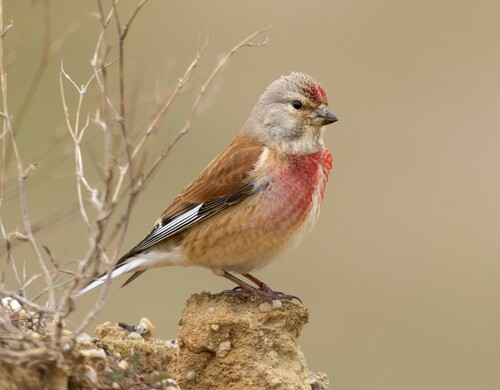
Eurasian Linnet
The Eurasian Linnet (*Linaria cannabina*) is a small, slender finch known for its melodious song and the male's distinctive crimson forehead and breast during the breeding season. These birds play a crucial role in seed dispersal across their wide range, contributing to the health and diversity of grassland and heathland ecosystems. While not globally threatened, some populations have faced declines due to agricultural intensification and habitat loss. The linnet has some cultural significance, often appearing in poetry and folklore as a symbol of freedom and the countryside.
12.5-14 cm
Length
21-25.5 cm
Wingspan
Least Concern
Conservation Status
Distribution
The Eurasian Linnet is found across Europe, western and central Asia, and parts of North Africa. It is a partial migrant, with northern populations moving south for the winter. Altitudinal range varies, occurring from sea level to mountainous regions, depending on the location.
Lifespan
Typically 2-3 years in the wild, but can live longer in captivity.
Eurasian Linnet's Habitat
Habitat Types
Open country, Heathland, Farmland, Coastal dunes, Scrubland
Climate Zones
Temperate, Mediterranean, Continental
Adaptations
Linnets are well-adapted to open habitats with scattered vegetation. Their strong, conical beaks are ideal for cracking seeds, their primary food source. Their relatively small size allows them to forage on the ground and in low bushes.
Variations
Several subspecies are recognized, differing slightly in plumage coloration and size. For example, *L. c. autochthona* is found in Scotland and is slightly darker than the nominate subspecies.
Appearance
Breeding Plumage
Males in breeding plumage have a crimson forehead and breast, while females and non-breeding males have streaked brown upperparts and buff underparts.
Seasonal Feather Changes
The male's crimson coloration fades after the breeding season.
Sex Based Plumage Differences
Significant during the breeding season, with males displaying bright crimson patches.
Notable Features
Conical bill adapted for seed-eating, Long, notched tail, White outer tail feathers visible in flight
Diet and Feeding
Primary Foods
Seeds, Small insects (especially during breeding season), Buds
Foraging Behavior
Linnets primarily forage on the ground, often in small flocks. They hop and peck at seeds, and may also glean insects from vegetation.
Specializations
Their strong, conical bill is perfectly adapted for cracking open seeds of various sizes.
Seasonal Diet Variations
The diet shifts to include more insects during the breeding season to provide protein for growing chicks. Seeds remain the staple food throughout the year.
Behavior
Social Structure
Linnets are often seen in flocks, especially outside the breeding season. During breeding, they may form loose colonies.
Communication
Melodious, twittering song, Contact calls described as a 'tsoo-eet', Alarm calls
Migration
Northern populations are migratory, while southern populations are often resident or only make short-distance movements.
Territorial or Group Behaviors
Males defend a small territory around the nest during the breeding season. Outside of breeding, they are generally gregarious.
Conservation
Threats
Agricultural intensification, Habitat loss due to urbanization, Pesticide use, Hedgerow removal
Protection Programs
Agri-environment schemes that promote habitat restoration, Protected areas within their range
Local National Laws
Protected under various national and international wildlife legislation, such as the EU Birds Directive.
Population Trend
Decreasing in some regions, particularly in Western Europe, but stable overall.
Population Estimates
The global population is estimated to be in the millions, but accurate figures are difficult to obtain.
Interesting Facts
The name 'Linnet' refers to their fondness for flax seeds.
The Latin name *cannabina* refers to hemp, another seed they favor.
Linnets can have multiple broods in a single breeding season.
This helps them to maximize reproductive success in favorable conditions.
They are known for their gentle and confiding nature.
This allows for close observation, but also makes them vulnerable to predators.
Faqs about Eurasian Linnet
What is the difference between a male and female Linnet?
Male Linnets in breeding plumage have a crimson forehead and breast, while females are streaked brown.
Where can I see Linnets?
Look for them in open country with scattered bushes and hedges, farmland, and coastal areas.
Are Linnets endangered?
The Eurasian Linnet is classified as Least Concern by the IUCN, but some populations are declining due to habitat loss.
What do Linnets eat?
Linnets primarily eat seeds, supplemented with insects during the breeding season.
Copyright @ Nature Style Limited. All Rights Reserved.
 English
English